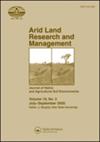干旱区双羽石斛的形态生理生化及叶表皮响应
IF 1.6
4区 农林科学
Q3 ENVIRONMENTAL SCIENCES
引用次数: 2
摘要
摘要研究了在土壤含水量为1.7 ~ 3.7 %,ECe =22.8 ~ 49.6 dS m−1的干旱区采集的双羽针茅(Desmostachya bipinnata L.)种群对干旱的适应性,评价了其形态生理、叶片表面属性和抗氧化能力的响应。在土壤属性中,研究了土壤pH、ECe、含水量、饱和度、有机质、P、Na+、K+、Ca2+、Mg2+、Cl、NH4-N、NO3-N以及与形态、生理、抗氧化电位相关的植物属性。随着干旱程度的增加,根冠比(0.1 ~ 0.4 cm)增加,平均叶面积(12 ~ 4 cm2)、茎部生物量(5 ~ 0.5 g)和根生物量(0.8 ~ 0.1g)显著降低。与叶绿素a (1 - 0.1 mg - 1鲜重)降解平行的是,类胡萝卜素含量(0.25-0.05 mg - 1鲜重)降低。随着干燥比的增加,除总可溶性糖增加(0.10 ~ 0.15 μmol g−1鲜重)外,其他有机渗透物均降低,抗氧化酶APX(0.5 ~ 3.5单位mg pro−1)、CAT(0.1 ~ 0.8单位mg pro−1)、POD(0.02 ~ 0.25单位mg pro−1)和SOD(2 ~ 7单位mg pro−1)活性增加。在可溶性阳离子中,随着干旱程度的增加,茎中Na+浓度增加(14 ~ 24 mgg−1 dw),而根和茎组织中K+ (35 ~ 15 mgg−1 dw)和Mg2+浓度降低(p < 0.05)。根系Ca2+浓度升高,N、P含量降低。综上所述,干旱减少了植物的营养生长,但促进了根系生长,从而更好地吸收深层水分,同时在表皮层沉积二氧化硅以控制水分流失。本文章由计算机程序翻译,如有差异,请以英文原文为准。
Morpho-physiological, biochemical, and leaf epidermal responses of Desmostachya bipinnata L. in arid habitats
Abstract The response of morpho-physiological and leaf surface attributes along with antioxidant potential of Desmostachya bipinnata L. populations collected from arid regions with 1.7–3.7 soil moisture % and =22.8–49.6 dS m−1 ECe was evaluated for adaptability to aridity. Among soil attributes, soil pH, ECe, moisture content, saturation percentage, organic matter, P, Na+, K+, Ca2+, Mg2+, Cl, NH4-N, NO3-N and plant attributes related to the morphology, physiology, antioxidant potential were studied. With increasing aridity root:shoot length ratio (0.1–0.4 cm) increased while average leaf area (12–4 cm2), shoot biomass (5–0.5 g), and root biomass (0.8–0.1g) decreased significantly. Parallel to that chlorophyll a (1–0.1 mgg−1 fresh weight) degradation was observed along with reduced carotenoid content (0.25–0.05 mgg−1 fresh weight). All other organic osmolytes decreased except for total soluble sugars which increased (0.10–0.15 μmol g−1 fresh weight) as the dryness ratio increased and more activities of the antioxidant enzymes APX (0.5–3.5 units mg pro−1), CAT (0.1–0.8 units mg pro−1), POD (0.02–0.25 units μg pro−1), and SOD (2–7 units mg pro−1) were observed. Among soluble cations, Na+ concentration increased (14–24 mg g−1 dw) in shoot as the aridity increased while shoot K+ (35–15 mgg−1 dw) and Mg2+ concentration decreased in both root and shoot tissues. Ca2+ concentration increased in root while N and P content decreased. In conclusion, aridity reduced overall vegetative growth but enhanced root growth for better absorption of water from the deeper layers with concurrent silica deposition in epidermal layers for controlling water loss.
求助全文
通过发布文献求助,成功后即可免费获取论文全文。
去求助
来源期刊

Arid Land Research and Management
环境科学-环境科学
CiteScore
3.80
自引率
7.10%
发文量
23
审稿时长
9 months
期刊介绍:
Arid Land Research and Management, a cooperating journal of the International Union of Soil Sciences , is a common outlet and a valuable source of information for fundamental and applied research on soils affected by aridity. This journal covers land ecology, including flora and fauna, as well as soil chemistry, biology, physics, and other edaphic aspects. The journal emphasizes recovery of degraded lands and practical, appropriate uses of soils. Reports of biotechnological applications to land use and recovery are included. Full papers and short notes, as well as review articles and book and meeting reviews are published.
 求助内容:
求助内容: 应助结果提醒方式:
应助结果提醒方式:


